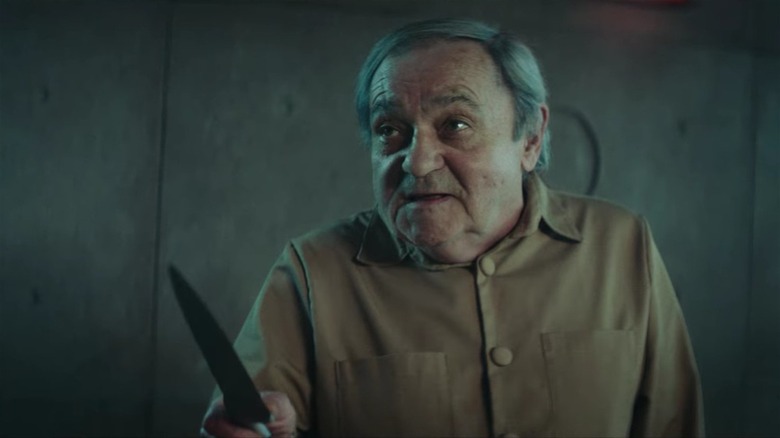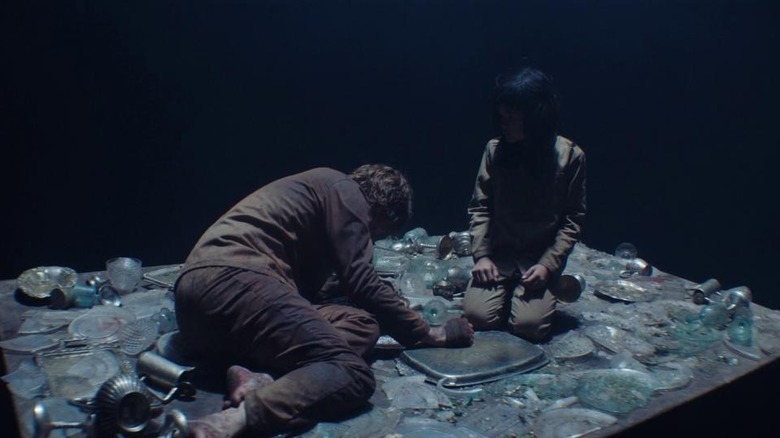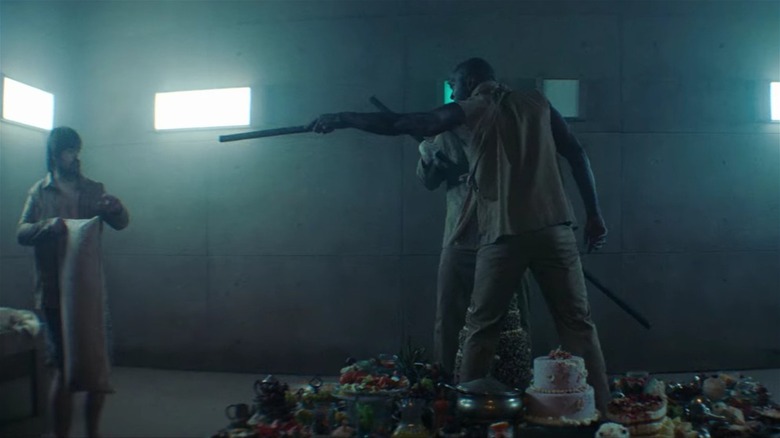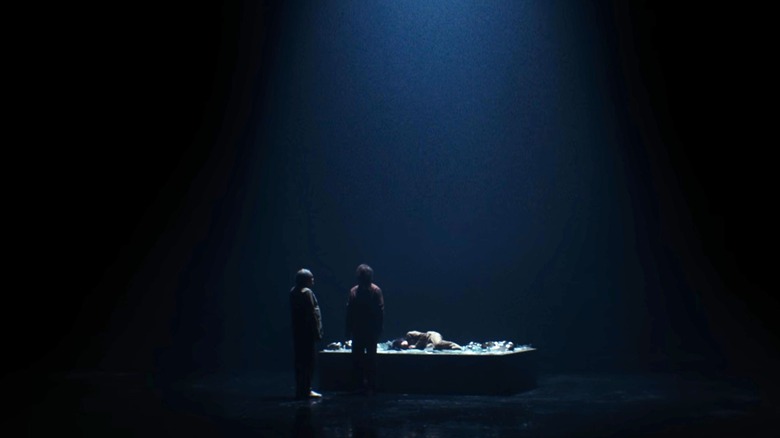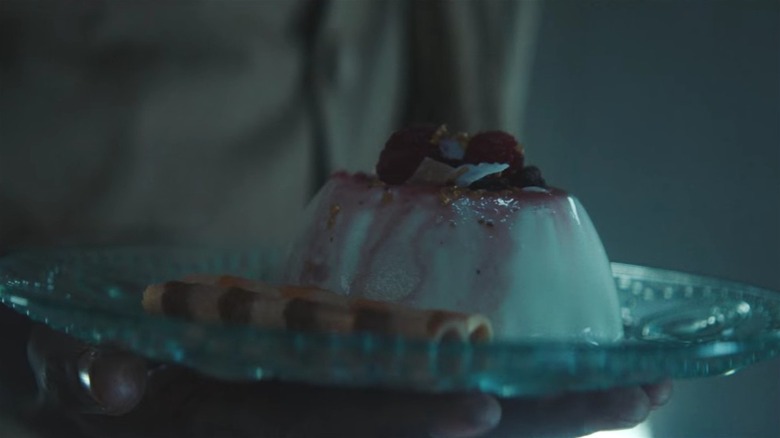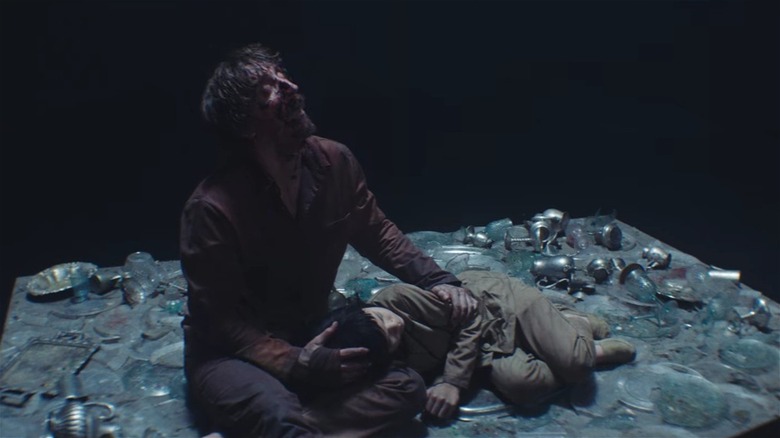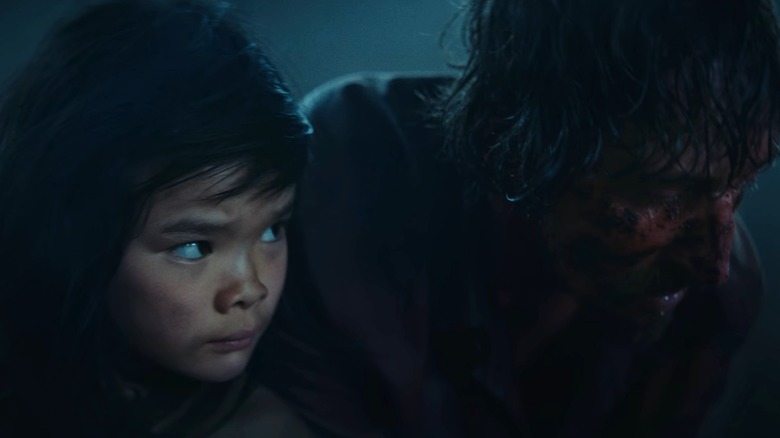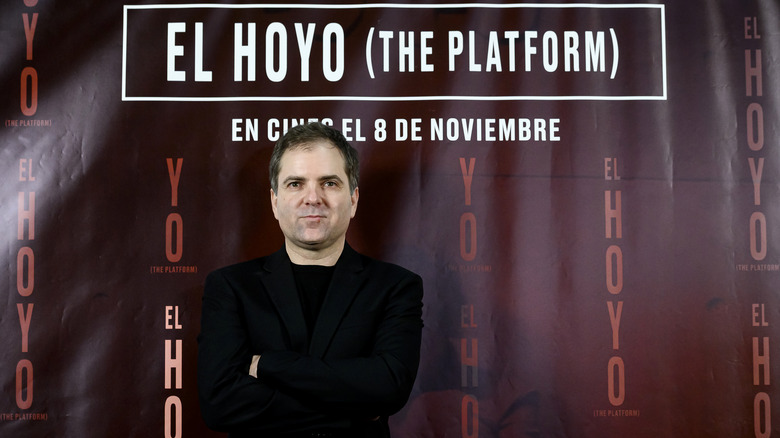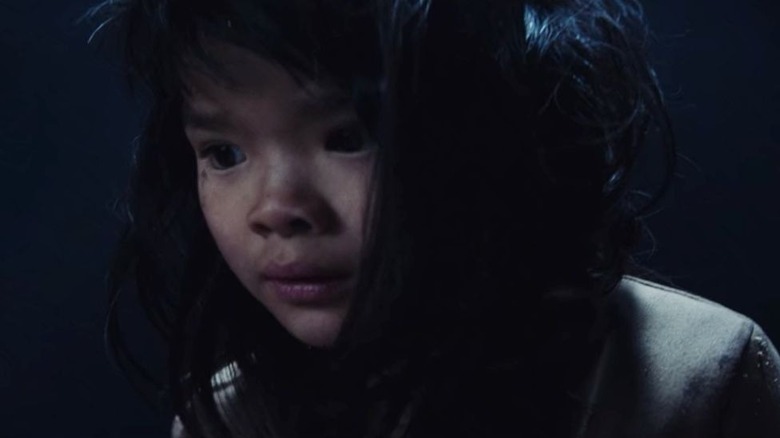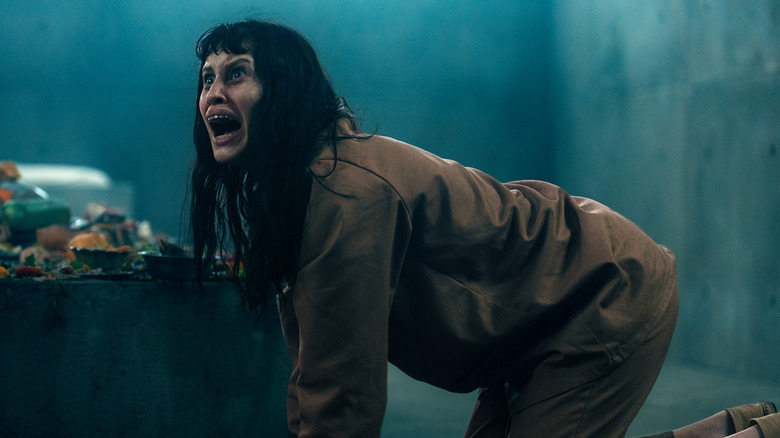The Platform Ending Explained: Are You Going To Eat That?
There was a lot going on in March 2020. On March 11, Tom Hanks announced he had COVID-19, the NBA shut down for the season, and Donald Trump addressed the American people, warning everyone about the oncoming pandemic. It felt like everything was coming to a head at once; by the end of that month, there would be stay-at-home orders around the world, and we would all become very familiar with phrases like "social distancing" and "self-quarantine."
Into all of that craziness came the Spanish horror film "The Platform," which Netflix released on March 20, 2020. The film imagines a prison that literalizes class struggle, the system giving resources to those on the upper levels and leaving the rest up to human nature. Of course, the people on top eat greedily, and as the platform moves down through the prison, those on the bottom floors have no chance at survival. Keep in mind that it was released two days after Gal Gadot and some famous friends shared a video of themselves singing "Imagine" from their luxury homes, facing backlash from every corner of the internet; in other words, class resentment was in the air.
Given the popularity and reception of the original — after all, it's one of Netflix's best international films – the streamer finally released "The Platform 2" in October 2024. This means it's likely been more than four years since many fans have rewatched the first film. Here's what you need to know.
What you need to remember about the plot of The Platform
A man named Goreng (Ivan Massagué) wakes up in a concrete cell marked "48." The movie is set in a prison with one cell per floor; each day, a floating platform piled with food passes down through each level. Those above gorge themselves. By the time the food reaches Goreng and his cellmate, Trimagasi (Zorion Eguileor), there's not much left. Trimagasi fills him in: Every month, the inmates move to a new, random floor. On lower levels, people don't eat at all, so they become violent and desperate. Each person was allowed to bring one item into prison; Goreng brought a copy of "Don Quixote," while Trimagasi brought an ultra-sharp knife.
They get along well enough, but then when their month is out, they wake up on Level 171. Trimagasi ties Goreng up, planning to cut strips of his flesh to eat until they are moved again. A prisoner named Miharu (Alexandra Masangkay), searching for her child, rides the platform down; she kills Trimagasi and frees Goreng. Goreng eats his cellmate and has visions of his ghost.
On Level 33, he's been reassigned to a room with Imoguiri (Antonia San Juan), an employee of the Administration. She volunteered to enter the prison, hoping to spark a revolution. Each day she tries to convince those lower than them to prepare portions for the people below still, hoping they'll change the culture within the prison. She claims there are only 200 levels, but the next month they are assigned to Level 202, and she hangs herself.
If you or someone you know is struggling or in crisis, help is available. Call or text 988 or chat 988lifeline.org.
What happened at the end of The Platform?
After Goreng subsists on Imoguiri's body for a month, plagued with visions of his dead cellmates, he reawakens on Level 6. This time he's been assigned to a man named Baharat (Emilio Buale). While they might be expected to just gorge themselves for a month on such a high level, Baharat has chosen to bring a rope, and he tries to climb higher in order to escape. The people on Level 5 won't cooperate, however, refusing to pull him up.
Instead, Goreng convinces his cellmate that they can change the prison if they ride the platform down, ensuring through force that everyone only eats what they need. He's done some calculations and concludes that the prison must have about 250 levels, so as long as they can survive that long, they'll be able to show the Administration that cooperation is possible.
Ultimately, the violence on the lower levels is far worse than anticipated. They try to protect a panna cotta all the way to the bottom, hoping to use it as a message, but they're unable to do so. When they come across Miharu being brutally killed, they leap to her defense, and both are mortally wounded. Goreng was unaware that the platform doesn't stop if there's no one left alive on that floor, so his calculations prove to have been wrong. They find a young girl on Level 333, and ultimately Goreng decides to send her back up, staying at the bottom with a vision of Trimagasi.
Why are there 333 floors?
Throughout "The Platform," it's difficult for the prisoners to figure out the exact parameters of the situation they've found themselves trapped in. Communication is really only possible for a few levels above and below, because people past that can't be trusted to pass on a message.
As a result, the prisoners have trouble figuring out just how deep the prison goes. Rumors spread easily throughout the facility, and it's not until Goreng and Imoguiri wake up on 202 that she even realizes there are more than 200 floors. Eventually, Goreng rides the platform all the way down to 333. So... why choose that number?
It's unclear, but there's one interesting thing about that choice that might give us a clue as to the Administration's intention. Each level ostensibly starts the month with two cellmates; two people on each of 333 floors means that there are 666 people in the prison. That's a number commonly associated with evil and with hell, which this prison certainly is.
What is the significance of the panna cotta?
As Goreng and Baharat descend through the prison, they come across a wise man (Eric L. Goode) whom Baharat has met before. He has a piece of advice for the two men, reminding them that the Administration as a whole is not going to care about their protest. On the other hand, the people who prepare the food all the way up on Level 0 might notice something symbolic.
To that end, he suggests that they feed everybody all the food from the table, except for one delicious-looking panna cotta. "Imagine their faces when they see the Hole send back a dish like that," the wise man says. "You must preserve the panna cotta as if your life depends on it." As they move down past the wise man's level, Goreng and Baharat decide that, yes, the panna cotta will be their message.
For the characters in the prison, the panna cotta serves as a reminder that it's nearly impossible to change an oppressive system all at once. But for the people working on Level 0, the panna cotta resembles both a middle finger extended to them and a reminder that the masses within the prison are still people deserving of empathy. "The Administration has no conscience," the wise man says. The best Goreng and Baharat can hope for is changing the minds of the individuals who work to uphold that system, hoping that the low-level people who interact with the prison each day are more likely to carry their revolutionary spark forward. If the panna cotta can make it back up to the top without being greedily devoured, then it will signal that something might've changed.
Why does the girl become the message?
Throughout the film, there have been hints that there might be a child in the prison. Trimagasi tells Goreng that Miharu is searching for her child; Imoguiri, on the other hand, insists that Miharu is insane and that the Administration would never put a child in the Hole. In the movie's final act, as Goreng and Baharat descend through the prison, they finally come across the child hiding on Level 333, far below anyone's understanding of how deep the prison goes.
She is, of course, starving; food barely makes it down past the first 50 levels, after all. They decide to feed the girl the panna cotta they've saved, and they are trapped on Level 333 with her. The next day, Goreng realizes, "The girl is the message." At the very bottom of the Hole, he sees another vision of Trimagasi and decides to get off the platform, sending her back up to the top alone. He is gravely injured and likely won't survive much longer, so he has no choice but to let her go on her own.
After all, as the hallucination of Trimagasi explains, "The message needs no bearer." This fits in with the film's overall exploration of the futility of protesting against an oppressive regime. Goreng isn't going to survive to overhaul the prison himself; instead, he has chosen to nourish the next generation, hoping that his message of protest will be carried forward by the people who outlive him.
How did the little girl survive in The Platform?
As "The Platform" goes on, it gradually becomes more and more about Miharu and her child. The existence of the girl somewhere in the prison feels mythic, like the characters are chasing a ghost, a symbol who may not actually exist. Ultimately, however, they discover her all the way at the bottom, down on level 333. How is it possible that a child could survive that long, so low and without food?
Experts disagree about how long humans can last without eating. After a man was found in a snowbound car and claimed to have lasted for two months without food, Dr. Mike Stroud told BBC News that it's possible to go that long with no sustenance. "The body needs more than just calories — it will start to shut down its organs one by one," he said. "But it could still take up to 60 days for that to happen."
If the little girl is being reshuffled between levels each month like everyone else, it's likely that she was able to eat at some point before Goreng found her. Even if it had been a long time since she'd seen any food, it's possible that she just hadn't yet died from starvation. There's also a chance that other prisoners might have taken pity on the helpless child, giving her something to eat to keep her alive. In short, we simply don't know, but any number of guesses probably work.
What has director Galder Gaztelu-Urrutia said about the ending of The Platform?
Director Galder Gaztelu-Urrutia spoke with Digital Spy about the end of "The Platform," clearing things up on both a plot level and an ideological one. First up, the plot: Gaztelu-Urrutia thinks Goreng is already dead in the film's final moments. "To me, that lowest level doesn't exist," he explained. "Goreng is dead before he arrives, and that's just his interpretation of what he felt he had to do." Gaztelu-Urrutia's explanation does make sense; after all, Goreng and Trimagasi seem to once again be conversing as equals, without the usual red tint that signals Goreng's hallucinations earlier in the film.
Ideologically, the final act complicates the mostly straightforward critique of capitalism the rest of the movie runs with. For most of the film, it's an obvious metaphor: The people at the top have all of the resources, and they care little about making sure enough trickles down to make sure those on the bottom can survive. Goreng and Baharat's attempt to feed everyone equally seems like the film advocates for socialism, but the movie understands that this is easier said than done. "As soon as Goreng and Baharat try out socialism to convince the other prisoners to willingly share their food, they end up killing half of the people they set out to help," Gaztelu-Urrutia pointed out. In other words, "The Platform" is bleak. It's inspiring that someone cares enough to try to affect change, but does it matter?
The Platform's alternate ending
"The Platform" was supposed to end differently. "Ultimately I wanted it to be open to interpretation, whether the plan worked and the higher-ups even care about the people in the pit. We actually did film a different ending of the girl arriving at the first level, but we took it out of the movie," director Galder Gaztelu-Urrutia told Digital Spy. "I'll leave what happens to your imagination."
Cutting this feels at first like a bit of a cop-out. If this ending had been left it in, Gaztelu-Urrutia would have had to resolve the film's themes of revolution and fighting for change. Instead, though, he wants to leave that interpretation up to each individual audience member. "At the end of the day, the movie isn't going to change the world," he said, "but it may change the viewer."
In that way, the girl does serve as a symbolic message, but to the audience rather than the characters. If we don't see how the Administration reacts, then we have to decide for ourselves whether she's a good enough message. "It's about the limits of your own solidarity and how easy it is to be a good person when you're comfortably in level 10, but how hard it is to do so when at level 182," Gaztelu-Urrutia elaborated. That's an uncomfortable question to leave viewers with, but it's one worth thinking about.
For more thrills and chills from overseas, be sure to check out Spanish horror films like "Sister Death," which ended up in Netflix's Top 10 charts for a time.
What the ending of The Platform means for the sequel
Warning: This section contains spoilers for "The Platform 2."
At the end of "The Platform," Goreng is on the lowest level. He's speaking with Trimagasi once again, who was very much dead, and we last see him as he's sent the girl back up to the top.
As "The Platform 2" opens, we learn that everyone in the prison is now aware of a "Messiah," someone who somehow survived down on 333 and has laid out a complex system of laws for them all to follow in an attempt to make food distribution more equitable. We first assume this is Goreng, and that his plan at the end of the first film was successful in inspiring change.
However, about halfway through the film, new protagonist Perempuán (Milena Smit) finds herself assigned to a new cellmate. It's Trimagasi, very much alive and evidently new to the prison. In an interesting twist, "The Platform 2" isn't a sequel after all, but a stealth prequel. This means Goreng wasn't the Messiah that this film is about, and it means that he did indeed die at the end of the first film, as the director intended to suggest. His "message" likely wasn't successful after all, but was just one in a long string of people like him, prisoners who tried to make the prison more equitable and ultimately failed, relying on hollow symbols that didn't amount to much. It's a chilling recontextualization of the first film.
If you enjoy creepy, suspenseful movies with a message, check out these films like "The Platform" you definitely need to see.
